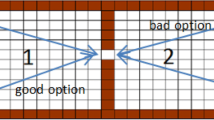Abstract
Hierarchical reinforcement learning (HRL) has had a vast range of applications in recent years. Preparing mechanisms for autonomous acquisition of skills has been a main topic of research in this area. While different methods have been proposed to achieve this goal, few methods have been shown to be successful both in performance and also efficiency in terms of time complexity of the algorithm. In this paper, a linear time algorithm is proposed to find subgoal states of the environment in early episodes of learning. Having subgoals available in early phases of a learning task, results in building skills that dramatically increase the convergence rate of the learning process.
Preview
Unable to display preview. Download preview PDF.
Similar content being viewed by others
References
Asadi, M., Huber, M.: Accelerating action dependent hierarchical reinforcement learning through autonomous subgoal discovery. In: Proceedings of the ICML 2005 Workshop on Rich Representations for Reinforcement Learning (2005)
Chen, F., Gao, Y., Chen, S., Ma, Z.: Connect-based subgoal discovery for options in hierarchical reinforcement learning. In: International Conference on Natural Computation, vol. 3 (2007)
Cormen, T.H., Leiserson, C.E., Rivest, R.L., Stein, C.: Introduction to Algorithms, 2nd edn. MIT Press, Cambridge (2001)
Dietterich, T.G.: Hierarchical reinforcement learning with the MAXQ value function decomposition. Journal of Artificial Intelligence Research 13, 227–303 (2000)
Lin, L.-J.: Self-improving reactive agents based on reinforcement learning, planning and teaching. Mach. Learn. 8(3-4), 293–321 (1992)
Mannor, S., Menache, I., Hoze, A., Klein, U.: Dynamic abstraction in reinforcement learning via clustering. In: Proceedings of the Twenty-First International Conference on Machine Learning, pp. 560–567. ACM Press, New York (2004)
McGovern, A., Barto, A.G.: Automatic discovery of subgoals in reinforcement learning using diverse density. In: International Conf. on Machine Learning, vol. 18, pp. 361–368. Morgan Kaufmann, San Francisco (2001)
Menache, I., Mannor, S., Shimkin, N.: Q-cut - dynamic discovery of sub-goals in reinforcement learning. In: Elomaa, T., Mannila, H., Toivonen, H. (eds.) ECML 2002. LNCS, vol. 2430, pp. 295–306. Springer, Heidelberg (2002)
Parr, R., Russell, S.: Reinforcement learning with hierarchies of machines. In: Jordan, M.I., Kearns, M.J., Solla, S.A. (eds.) Advances in Neural Information Processing Systems, vol. 10, pp. 167–173. MIT Press, Cambridge (1997)
Şimşek, Ö., Barto, A.G.: Using relative novelty to identify useful temporal abstractions in reinforcement learning. In: International Conference on Machine Learning, vol. 21, pp. 751–758. ACM Press, New York (2004)
Şimşek, Ö., Wolfe, A.P., Barto, A.G.: Identifying useful subgoals in reinforcement learning by local graph partitioning. In: International Conference on Machine Learning, Bonn, Germany, vol. 22 (2005)
Stolle, M., Precup, D.: Learning options in reinforcement learning. In: Koenig, S., Holte, R.C. (eds.) SARA 2002. LNCS, vol. 2371, pp. 212–223. Springer, Heidelberg (2002)
Sutton, R.S., Barto, A.G.: Reinforcement Learning: An Introduction (Adaptive Computation and Machine Learning). MIT Press, Cambridge (1998)
Sutton, R.S., Precup, D., Singh, S.P.: Between MDPs and semi-MDPs: A framework for temporal abstraction in reinforcement learning. Artificial Intelligence 112(1-2), 181–211 (1999)
Sutton, R.S., Singh, S.P., Precup, D., Ravindran, B.: Improved switching among temporally abstract actions. In: International Conference on Machine Learning, vol. 15. Morgan Kaufmann, San Francisco (1998)
Author information
Authors and Affiliations
Editor information
Editors and Affiliations
Rights and permissions
Copyright information
© 2009 Springer-Verlag Berlin Heidelberg
About this paper
Cite this paper
Kazemitabar, S.J., Beigy, H. (2009). Using Strongly Connected Components as a Basis for Autonomous Skill Acquisition in Reinforcement Learning. In: Yu, W., He, H., Zhang, N. (eds) Advances in Neural Networks – ISNN 2009. ISNN 2009. Lecture Notes in Computer Science, vol 5551. Springer, Berlin, Heidelberg. https://doi.org/10.1007/978-3-642-01507-6_89
Download citation
DOI: https://doi.org/10.1007/978-3-642-01507-6_89
Publisher Name: Springer, Berlin, Heidelberg
Print ISBN: 978-3-642-01506-9
Online ISBN: 978-3-642-01507-6
eBook Packages: Computer ScienceComputer Science (R0)




